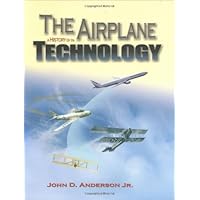
Average Reviews:

(More customer reviews)With the publication of John Anderson's seminal overview of the history of aerodynamics, "A History of Aerodynamics, and Its Impact on Flying Machines" (Cambridge University Press, 1997), the former Glenn L. Martin Distinguished Professor of aerospace engineering at the University of Maryland and current curator for aerodynamics at the Smithsonian Institution's National Air and Space Museum established himself as the preeminent interpreter of the history of flight technology in the United States. This book solidifies Anderson's stature with its outstanding analysis of the evolution of the airplane from its origins before the Wright brothers through the design revolution wrought by the advent of jet propulsion.
Anderson begins with an introduction that serves as chapter 1. He then offers six additional chapters chronologically exploring the development of aeronautics. These include: (2) aeronautical thought and research before the nineteenth century, (3) work during the nineteenth century but before the Wright brothers, (4) the efforts of the Wrights and their revolutionary Flyer, (5) the era of the strut-and-wire biplane which Anderson characterizes as "seat-of-the-pants" design, (6) the development of the mature propeller-driven airplane which the author considers the first design revolution, (7) and the second design revolution wrought by jet propulsion.
This work is written for the general reader, and Anderson does a fine job of communicating difficult concepts without reliance on jargon and a plethora of equations. There are a few of the latter, but they are kept to a minimum and the author takes pains to explain them clearly. This is also a large format book well illustrated with diagrams and photographs that do much than just decorate the text by serving to illustrate the principles of flight.
Anderson also does a good job of demonstrating the state of the art of flight at critical points in the evolution of the airplane. For example, while most people believe that Wilbur and Orville Wright "invented" the airplane, Anderson shows that the idea of the airplane predated them by centuries and that they inherited a considerable body of knowledge about the principles of flight. This, and their own work, enabled the Wrights to fly the first successful airplane. Others following in their footsteps significantly advanced knowledge about the technology of flight and brought us to the point we are now. Always, Anderson explores the evolution of the major technologies required for flight: aerodynamics, materials and structures, propulsion, guidance and control, and the systems and processes that guide the development of any airplane.
While there are no footnotes in the text, there is a bibliography and Anderson often refers to specific publications in his text. Prepared in commemoration of the 100th anniversary of powered flight, this is quite an excellent work and highly recommended.
Click Here to see more reviews about: The Airplane: A History of Its Technology (Library of Flight Series)
This new book was commissioned in celebration of the100th Anniversary of Powered Flight. It is written by one the mostrespected authors in the aerospace world. John D. Anderson Jr. iscurator for aerodynamics at the National Air and Space Museum,Professor Emeritus, Department of Aerospace Engineering, University ofMaryland, and the author of several world-renowned textbooks.Contrary to popular belief, the Wright brothers did not invent theairplane; rather they invented the first successful airplane. Theconcept of the airplane was invented a hundred years earlier, and theWrights inherited a century's worth of prior aeronautical research anddevelopment. The Wrights did not work in a vacuum; they admitted thatthey "worked on the shoulders of giants." Indeed, if Orville andWilbur had not entered the field of aeronautics, and their momentousflight on 17 December 1903 had not taken place, the first successfulairplane would have been invented by someone else within thedecade. The time was right. The Wrights were the right people at theright time.Just what aeronautical technology did the Wrights inherit from their predecessors? How much was right? How much was wrong? Who were the major players in the development of this technology and why?This book will answer those questions. It is a history of the technology of the airplane, written with the nontechnical reader in mind, but telling a story that the technical reader can also enjoy. This history begins centuries before the Wright brothers and takes us to the present day. "After you finish this book, I hope that the next time you get on an airplane, you will feel the history of its technology. If you do, then I will have accomplished my goal." -- John D. Anderson Jr.Technical and nontechnical readers alike will find this book fascinating reading.

0 comments:
Post a Comment